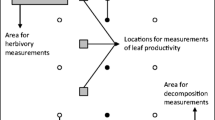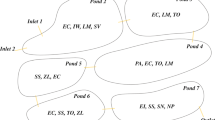Abstract
Fixation of river flow passages and riverbed degradation may facilitate the development of higher floodplains with the establishment of exotic species such as black locust (Robinia pseudoacacia L.). We quantitatively evaluated the relationship between nitrogen (N) levels in black locust trees and in sediments under different flood disturbance regimes in a riparian area of the Chikuma River. In this study, allometric equations were developed for relating leaf N content to diameter at breast height of black locust. The amount of leaf N in black locust increased with distance from the river, reaching 159 kg N ha−1 at 180 m from the river. There was a small difference in N content between green and fallen leaves (0.2%), and so the leaf N was almost equivalent to N input to riparian sediments. Fine sediments accumulated on the riparian area, where the amount of sediments N increased with distance from the river, ranging from 1091 ± 767 to 4953 ± 2953 kg N ha−1. The N accumulation rates also increased with distance from the river, corresponding with the amount of leaf N in black locust per unit area, but the former exceeded the latter. The sediment N accumulation might be accelerated by sediment trapping effect due to riparian vegetation itself. A large input of N provided by invaded black locust might alter nutrient dynamics and native plant community structure in the riparian area.






Similar content being viewed by others
References
Akamatsu F, Toda H, Okino T (2004) Food source of riparian spiders analyzed by using stable isotope ratios. Ecol Res 19:655–662
Akamatsu F, Shimano K, Toda H, Okino T (2007) Nitrogen uptake by riparian plants in relation to topography along the Chikuma River, Japan. Ecol Civ Eng 10:191–198 (in Japanese with English abstract)
Akamatsu F, Shimano K, Denda M, Ide K, Ishihara M, Toda H (2008) Effects of sediment removal on nitrogen uptake by riparian plants in the higher floodplain of the Chikuma River, Japan. Landsc Ecol Eng 4:91–96
Amano K, Denda M, Tokioka T, Ohishi T (2006) An attempt to assess habitat function of reach scale river morphology led by hydraulic characteristics during floods. Adv River Eng 12:483–488 (in Japanese with English abstract)
Asaeda T, Siong K, Kawashima T, Sakamoto K (2009) Growth of Phragmites japonica on a sandbar of regulated river: morphological adaptation of the plant to low water and nutrient availability in the substrate. River Res Appl 25:874–891
Binkley D, Sollins P, Bell R, Saches D, Myrold D (1992) Biogeochemistry of adjacent conifer and alder-conifer stands. Ecology 73:2022–2033
Boring LR, Swank WT (1984) Symbiotic nitrogen fixation in regenerating black locust (Robinia pseudoacacia L.) stands. For Sci 30:528–537
Ecological Society of Japan (2002) Handbook of alien species in Japan. Chijinshokan, Tokyo (in Japanese)
Fukuda M, Sakio H, Maruta E (2005) Seedlings establishment of exotic tree Robinia pseudoacacia L. on the flood plain of the Arakawa River. Jpn J Ecol 55:387–395 (in Japanese)
Gotoh H, Sakai T, Hayashi M (2001) Lagrangian particle method for analysis of dam-up process by drift timbers. Annu J Hydraul Eng JSCE 45:919–924 (in Japanese with English abstract)
Helfield JM, Naiman RJ (2002) Salmon and alder as nitrogen sources to riparian forests in a boreal Alaskan watershed. Oecologia 133:573–582
Hickin EJ (1984) Vegetation and river channel dynamics. Can Geogr 28:111–126
Hobbs RJ, Huenneke LF (1992) Disturbance, diversity, and invasion: implications for conservation. Conserv Biol 6:324–337
Ishida S, Nakashizuka T, Gonda Y, Kamitani T (2008) Effects of flooding and artificial burning disturbances on plant species composition in a down stream riverside floodplain. Ecol Res 23:745–755
Japan Meteorological Agency (2009) Climatic statistics. http://www.jma.go.jp/jma/index.html
Kurten EL, Snyder CP, Iwata T, Vitousek PM (2008) Morella cerifera invasion and nitrogen cycling on a lowland Hawaiian lava flow. Biol Invasions 10:19–24
Lee S, Fujita K, Yamamoto K (1999) A scenario of area expansion of stable vegetation in a gravel-bed river based on the upper Tama River case. Annu J Hydraul Eng JSCE 43:977–982 (in Japanese with English abstract)
Lee CS, Cho HJ, Yi H (2004) Stand dynamics of introduced black locust (Robinia pseudoacacia L.) plantation under different disturbance regimes in Korea. For Ecol Manag 189:281–293
Levine JM, Vilà M, D’Antonio CM, Dukes JS, Grigulis K, Lavorel S (2003) Mechanisms underlying the impacts of exotic plant invasions. Proc R Soc Lond B 270:775–781
Maekawa M, Nakagoshi N (1997) Riparian landscape changes over a period of 46 years, on the Azusa River in Central Japan. Landsc Urban plan 37:37–43
Malcolm GM, Bush DS, Rice SK (2008) Soil nitrogen conditions approach preinvasion levels following restoration of nitrogen-fixing black locust (Robinia pseudoacacia) stands in a pine-oak ecosystem. Restor Ecol 16:70–78
Maron JL, Connors PG (1996) A native nitrogen-fixing shrub facilitates weed invasion. Oecologia 105:302–312
Matus G, Tóthmérész B, Papp M (2003) Restoration prospects of abandoned species-rich sandy grassland in Hungary. Appl Veg Sci 6:169–178
Melville BW, Dongol DM (1992) Bridge pier scour with debris accumulation. J Hydraul Eng 118:1306–1310
Morimoto J, Kominami R, Koike T (2010) Distribution and characteristics of the soil seed bank of the black locust (Robinia pseudoacacia) in a headwater basin in northern Japan. Landsc Ecol Eng 6:193–199
Muranaka T, Ishii J, Miyawaki S, Washitani I (2005) Vascular plants to be designated as invasive alien species according to the invasive alien species act of Japan. Jpn J Conserv Ecol 10:19–33 (in Japanese with English abstract)
Nilsson C, Jansson R, Zinko U (1997) Long-term responses of river-margin vegetation to water-level regulation. Science 276:798–800
Okino T, Chikuma River Research Group (2006) River ecosystems formed by flooding. The Shinano Mainichishinbun, Nagano (in Japanese)
Osugi T, Tate S, Takemura K, Watanabe W, Ogura N, Kikkawa J (2007) Ecological research for the restoration and management of rivers and reservoirs in Japan. Landsc Ecol Eng 3:159–170
Reich PB, Grigal DF, Aber JD, Gower ST (1997) Nitrogen mineralization and productivity in 50 hardwood and conifer stands on diverse soils. Ecology 78:335–347
Rice SK, Westerman B, Federicic R (2004) Impacts of the exotic, nitrogen-fixing black locust (Robinia pseudoacacia) on nitrogen-cycling in a pine-oak ecosystem. Plant Ecol 174:97–107
Riis T, Suren AM, Clausen B, Sand-Jensen K (2008) Vegetation and flow regime in lowland streams. Freshw Biol 53:1531–1543
Shimizu Y, Osada K (2007) Numerical experiments on accumulation process of driftwoods around piers by using a DEM-flow coupling model. Annu J Hydraul Eng JSCE 51:829–834 (in Japanese with English abstract)
Shin N, Nakamura F (2005) Effects of fluvial geomorphology on riparian tree species in Rekifune River, northern Japan. Plant Ecol 178:15–28
Suetsugi T, Hattori A, Sezaki T (2001) Changes in riparian vegetation with flood disturbances. Water Sci 45:33–47 (in Japanese)
Swanson FJ, Gregory SV, Sedell JR, Campbell AG (1982) Land–water interactions: the riparian zone. In: Edomonds RL (ed) Analysis of coniferous forest ecosystem in the western United States. Hutchinson Ross Pub Co, Pennsylvania, pp 267–291
Tamai N (2004) Principles in eco-compatible river basin management. University of Tokyo Press, Tokyo (in Japanese)
Tanaka N, Yagisawa J (2009) Effects of tree characteristics and sediment condition on critical breaking moment of trees due to heavy flooding. Landsc Ecol Eng 5:59–70
Taniguchi T, Tmani S, Yamanaka N, Futai K (2007) Inhibition of the regeneration of Japanese black pine (Pinus thunbergii) by black locust (Robinia pseudoacacia) in coastal sand dunes. J For Res 12:350–357
Vitousek PM, Walker LR (1989) Biological invasion by Myrica faya in Hawai’i: plant demography, nitrogen fixation, ecosystem effects. Ecol Monogr 59:247–265
Ward JV (1998) Riverine landscapes: biodiversity patterns, disturbance regimes, and aquatic conservation. Biol Conserv 83:269–278
Ward JV, Tockner K (2001) Biodiversity: towards a unifying theme for river ecology. Freshw Biol 46:807–819
Yanai S, Kochi K (2005) Effects of salmon carcasses on experimental stream ecosystems in Hokkaido, Japan. Ecol Res 20:471–480
Yelenik SG, Stock WD, Richardson DM (2004) Ecosystem level impacts of invasive Acacia saligna in the South African Fynbos. Restor Ecol 12:44–51
Yoshimura C, Omura T, Furumai H, Tockner K (2005) Present state of rivers and streams in Japan. River Res Appl 21:93–112
Zak DR, Pregitzer KS (1990) Spatial and temporal variability of nitrogen cycling in northern lower Michigan. For Sci 36:367–380
Acknowledgments
We are grateful to members of the Department of Environmental Sciences, Shinshu University for their assistance with fieldwork. We also thank two anonymous reviewers for their valuable suggestions and critical comments. This study was supported by the River Ecology Research Group of Japan.
Author information
Authors and Affiliations
Corresponding author
Rights and permissions
About this article
Cite this article
Akamatsu, F., Ide, K., Shimano, K. et al. Nitrogen stocks in a riparian area invaded by N-fixing black locust (Robinia pseudoacacia L.). Landscape Ecol Eng 7, 109–115 (2011). https://doi.org/10.1007/s11355-010-0125-0
Received:
Revised:
Accepted:
Published:
Issue Date:
DOI: https://doi.org/10.1007/s11355-010-0125-0




